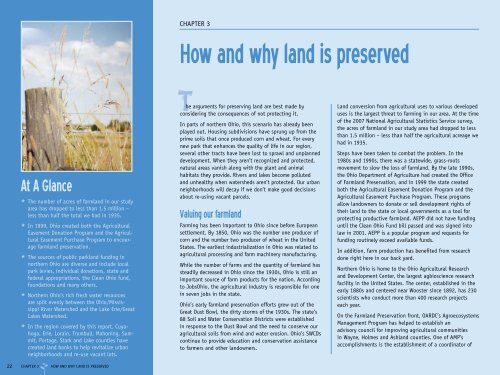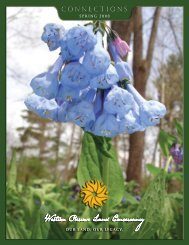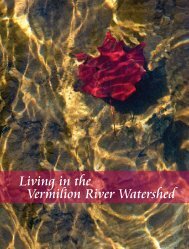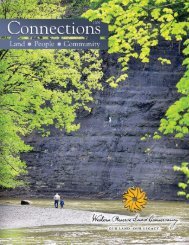Common Ground - Western Reserve Land Conservancy
Common Ground - Western Reserve Land Conservancy
Common Ground - Western Reserve Land Conservancy
You also want an ePaper? Increase the reach of your titles
YUMPU automatically turns print PDFs into web optimized ePapers that Google loves.
At A Glance<br />
* The number of acres of farmland in our study<br />
* In 1999, Ohio created both the Agricultural<br />
* The sources of public parkland funding in<br />
* Northern Ohio’s rich fresh water resources<br />
* In the region covered by this report, Cuya-<br />
area has dropped to less than 1.5 million –<br />
less than half the total we had in 1935.<br />
Easement Donation Program and the Agricultural<br />
Easement Purchase Program to encourage<br />
farmland preservation.<br />
northern Ohio are diverse and include local<br />
park levies, individual donations, state and<br />
federal appropriations, the Clean Ohio fund,<br />
foundations and many others.<br />
are split evenly between the Ohio/Mississippi<br />
River Watershed and the Lake Erie/Great<br />
Lakes Watershed.<br />
hoga, Erie, Lorain, Trumbull, Mahoning, Summit,<br />
Portage, Stark and Lake counties have<br />
created land banks to help revitalize urban<br />
neighborhoods and re-use vacant lots.<br />
22 22 CHAPTER CHAPTER 3 3 HOW HOW AND AND WHY WHY LAND LAND IS IS PRESERVED PRESERVED<br />
CHAPTER 3<br />
How and why land is preserved<br />
T he arguments for preserving land are best made by<br />
considering the consequences of not protecting it.<br />
In parts of northern Ohio, this scenario has already been<br />
played out. Housing subdivisions have sprung up from the<br />
prime soils that once produced corn and wheat. For every<br />
new park that enhances the quality of life in our region,<br />
several other tracts have been lost to sprawl and unplanned<br />
development. When they aren’t recognized and protected,<br />
natural areas vanish along with the plant and animal<br />
habitats they provide. Rivers and lakes become polluted<br />
and unhealthy when watersheds aren’t protected. Our urban<br />
neighborhoods will decay if we don’t make good decisions<br />
about re-using vacant parcels.<br />
Valuing our farmland<br />
Farming has been important to Ohio since before European<br />
settlement. By 1850, Ohio was the number one producer of<br />
corn and the number two producer of wheat in the United<br />
States. The earliest industrialization in Ohio was related to<br />
agricultural processing and farm machinery manufacturing.<br />
While the number of farms and the quantity of farmland has<br />
steadily decreased in Ohio since the 1930s, Ohio is still an<br />
important source of farm products for the nation. According<br />
to JobsOhio, the agricultural industry is responsible for one<br />
in seven jobs in the state.<br />
Ohio’s early farmland preservation efforts grew out of the<br />
Great Dust Bowl, the dirty storms of the 1930s. The state’s<br />
88 Soil and Water Conservation Districts were established<br />
in response to the Dust Bowl and the need to conserve our<br />
agricultural soils from wind and water erosion. Ohio’s SWCDs<br />
continue to provide education and conservation assistance<br />
to farmers and other landowners.<br />
<strong>Land</strong> conversion from agricultural uses to various developed<br />
uses is the largest threat to farming in our area. At the time<br />
of the 2007 National Agricultural Statistics Service survey,<br />
the acres of farmland in our study area had dropped to less<br />
than 1.5 million – less than half the agricultural acreage we<br />
had in 1935.<br />
Steps have been taken to combat the problem. In the<br />
1980s and 1990s, there was a statewide, grass-roots<br />
movement to slow the loss of farmland. By the late 1990s,<br />
the Ohio Department of Agriculture had created the Office<br />
of Farmland Preservation, and in 1999 the state created<br />
both the Agricultural Easement Donation Program and the<br />
Agricultural Easement Purchase Program. These programs<br />
allow landowners to donate or sell development rights of<br />
their land to the state or local governments as a tool for<br />
protecting productive farmland. AEPP did not have funding<br />
until the Clean Ohio Fund bill passed and was signed into<br />
law in 2001. AEPP is a popular program and requests for<br />
funding routinely exceed available funds.<br />
In addition, farm production has benefited from research<br />
done right here in our back yard.<br />
Northern Ohio is home to the Ohio Agricultural Research<br />
and Development Center, the largest agbioscience research<br />
facility in the United States. The center, established in the<br />
early 1880s and centered near Wooster since 1892, has 230<br />
scientists who conduct more than 400 research projects<br />
each year.<br />
On the Farmland Preservation front, OARDC’s Agroecosystems<br />
Management Program has helped to establish an<br />
advisory council for improving agricultural communities<br />
in Wayne, Holmes and Ashland counties. One of AMP’s<br />
accomplishments is the establishment of a coordinator of









